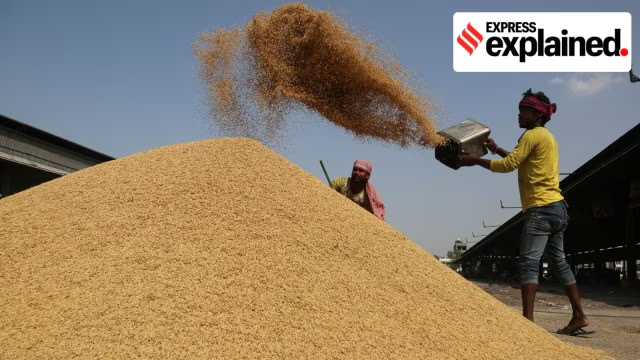Tags
How paddy variety PR-126 became a victim of its own popularity
The Punjab Agricultural University’s short-duration paddy variety is at the centre of controversy in the state for its allegedly low milling out-turn. But the real culprit might be non-certified hybrids that seem to have flooded the market
Written by Anju Agnihotri Chaba

Eight years after it was introduced in 2016, the widely cultivated short-duration paddy variety PR-126 finds itself at the centre of controversy in Punjab.
Citing lower out-turn ratio (OTR, which refers to the post milling yield), rice shellers are reportedly refusing to accept the PR-126 and hybrid varieties.
The opposition in the state has picked up the issue, with Congress leader Partap Singh Bajwa slamming Bhagwant Mann’s AAP government for its “ill-advised” promotion of the paddy variety. “Paddy procurement has slowed to a crawl, leaving farmers stranded in mandis for days,” Bajwa claimed.
Punjab Chief Minister Mann on Thursday clapped back, accusing Bajwa of spreading “half-baked knowledge”, and saying that paddy procurement is going on smoothly.
Story of PR-126
Paddy is an extremely water-intensive crop. Despite Punjab facing a severe groundwater crisis, the state has seen a record-high area under paddy cultivation (roughly 32 lakh hectares) in the 2023-24 and 2024-25 seasons.
In this context, shifting to paddy varieties which can be grown in a shorter duration likely offers the best solution for the water crisis. This is where PR-126 comes in. Introduced by the Punjab Agricultural University (PAU) in 2016, the variety became popular among farmers for its shorter growth period, high yield, minimal pesticide requirements, and excellent OTR. It offers an average yield of over 30 quintals per acre.
In 2023, PR-126 was cultivated on an area of approximately 8.59 lakh hectares, accounting for almost 33% of the area cultivated with non-Basmati paddy in Punjab. This number is expected to increase to 44% this year.
PAU Vice Chancellor Dr Satvir Singh Gosal, in a conversation with The Indian Express, described PR-126 as a blessing for Punjab in the light of extensive paddy cultivation in the state. He said that the variety’s shorter duration does not just save a month’s worth of water needed for irrigation, but also allows farmers greater time to manage stubble, reducing the need for burning.
Concerns regarding hybrids
For the last eight years, rice shellers have seldom raised an issue with PR-126. This is why Dr Gosal is not convinced about criticisms this year regarding the variety’s allegedly low OTR.
“When we release any new variety, we test it for three years from every possible angle, including yield and resistance to pests,” Dr Gosal said, adding that a committee comprising scientists from PAU, state government officials as well as members of rice millers’ association was responsible for approving all new varieties.
Dr Gosal said that PR-126’s milling out-turn has consistently been excellent, and millers have never raised issues with the crop before. “Even during a meeting held in May, before the paddy sowing season, millers confirmed they had no problem with PR-126,” he said.
Concerns were raised, however, regarding hybrid varieties which seem to have flooded the market this year. This is what lies at the heart of the PR-126’s recent troubles.
Tarsem Saini, President of the Punjab Rice Millers’ Association, clarified that millers do not have a problem with PR-126 per say. Rather, they are concerned about hybrid varieties sold under the name of PR-126. He said that the OTR for hybrid varieties was only 60%-62%, as against PR-126’s 67%.
“We are refusing to take varities sold as PR-126, and asking PAU to take samples of these varieties to conduct DNA tests to reveal the truth,” Saini said. “We will not mill paddy until trials are conducted, and a new policy is set regarding hybrid varieties’ out-turn. We suffered huge losses last year,” Saini told The Indian Express.
Victim of own popularity
Several farmers, who sowed hybrid varieties, told The Indian Express that they purchased the seed from either their arhtiyas (commission agents) or seed and pesticide dealers.
“This year, the demand for PR-126 was huge, and when enough seed wasn’t available, seed and pesticide companies took advantage of the situation by selling hybrid varieties under the PR-126 name,” Saini said.
Dr Gosal explained that PAU does not recommend hybrid paddy varieties because they have thus far not been successful in terms of yield, unlike hybrids of other crops. Moreover, he said that they are also much more expensive — sometimes 50 to 60 times more expensive than PAU-certified seeds — because hybrid seeds need to be produced each year. He said that the state government must ensure that only PAU-recommended seeds are sold in Punjab, to protect farmers from exploitation and avoid such controversies in the future.
The Punjab government has issued a directive for PR-126 and hybrid varieties to be stocked separately in the rice mills, so that milling trials can be carried out to determine actual OTR of various varieties.
Published Date: October 18, 2024






